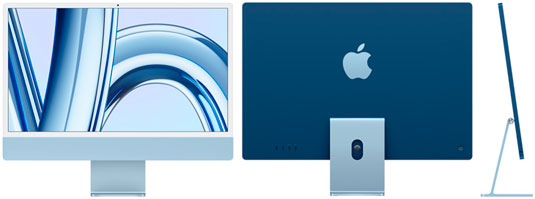Hosted by site sponsor WebMate.
Colorful Apple Silicon iMac Q&A
Published December 13, 2023
All Mac Q&As >> Colorful Apple Silicon iMac Q&A (Home)
To be notified of new Q&As, sign up for EveryMac.com's bimonthly email list.
What are all the differences between the "2023 M3" iMac models? Which is best for me?
There are two different Apple Silicon "2023 M3" iMac models -- the iMac "M3" 8 CPU/8 GPU/2 Ports 24" (2023) and iMac "M3" 8 CPU/10 GPU/4 Ports 24" (2023).
With a quick look at these iMac models, they seem essentially identical. However, there are differences, mostly subtle, that are important to understand in order to determine which is best for you.

Photo Credit: Apple, Inc. (iMac 2023 M3)
External Differences
Both "2023 M3" iMac models use the same wafer thin, all aluminum design with flat sides and a light gray frame around the display and a small "chin" underneath. By default, these iMac models are mounted on an aluminum stand and are not VESA compliant, but they can be configured with a VESA mount option instead of the stand at the time of purchase at no extra charge.
Despite their formal marketing as "24-Inch" 4.5K Retina displays, the "2023 M3" iMac models actually have the same slightly smaller 23.5-Inch LED-backlit widescreen TFT active matrix "Retina 4.5K" display with a native resolution of 4480x2520 at 218 ppi with "support for 1 billion colors," True Tone technology, wide color (P3), and brightness of 500 nits.
Both models also pack a 1080p FaceTime HD camera, three-mic array, and six-speaker system for video conferencing.
Ports are the major point of external differentiation between the two options. Both have a 3.5-mm headphone jack conveniently located on the left side of the display in addition to Wi-Fi 6E (802.11ax) and Bluetooth 5.3.
However, the entry-level iMac "M3" 8 CPU/8 GPU/2 Ports 24" (2023) has two USB-C shaped Thunderbolt / USB 4 ports whereas the higher-end iMac "M3" 8 CPU/10 GPU/4 Ports 24" (2023) has four USB-C shaped ports, but two of the ports support Thunderbolt 4 / USB 4 and the other two support the slower USB 3 standard.
The higher-end model also includes a power supply that includes a Gigabit Ethernet port. The entry-level model is bundled with a power supply that lacks a Gigabit Ethernet port by default, but it can be upgraded to the same power supply as the higher-end model at the time of initial purchase for an extra US$30.
Color Differences
The "2023 M3" iMac models are offered in seven color options -- blue, green, pink, silver, yellow, orange, and purple. The colors are dark on the back and sides of each system and a lighter shade of the same color on the front below the light gray bezel that wraps around the display.

Photo Credit: Apple, Inc. (iMac 2023 M3 Color Options)
However, not all colors are available for the entry-level iMac. The entry-level model only is provided in blue, green, pink, and silver, whereas the higher-end model is available in the same colors as the entry-level model and adds yellow, orange, and purple options.
Included Accessory Differences
The "2023 M3" iMac models include different color-matched input accessories by default.
Both models ship with a wireless "Magic Mouse" with multi-touch surface support, but the entry-level model includes a small aluminum wireless "Magic Keyboard" (A2450, EMC 3619) without "Touch ID" or a numeric keypad. The higher-end model has a small aluminum wireless "Magic Keyboard with Touch ID" (A2449, EMC 3579), but it still lacks a numeric keypad.

Photo Credit: Apple, Inc. (Magic Keyboard with Touch ID and Numeric Keypad)
At the time of system purchase, the entry-level iMac can be configured with the same "Touch ID" equipped keyboard as its higher-end sibling for an extra US$50. Either model also can be configured with a "Magic Keyboard with Touch ID and Numeric Keypad" (A2520, EMC 3957) for an additional US$80 for the entry-level model and an additional US$30 for the higher-end model.
Either model additionally can be configured at the time of purchase to include a Magic Trackpad (which provides multi-touch input and Force Touch support) in lieu of the Magic Mouse for an extra US$50 or include both a Magic Mouse and a Magic Trackpad for an additional US$129.
Identification Differences
The "2023 M3" iMac models look essentially identical to earlier models, so specific identification details are especially useful. As the site has done for more than two decades now, EveryMac.com has hand documented these identifiers. You're welcome.
Model Numbers commonly are shared by later models and are not ideal for long-term identification, accordingly, At the time of introduction, though, the Model Numbers are unique for the "2023 M3" iMac models. The entry-level iMac "M3" 8 CPU/8 GPU/2 Ports 24" (2023) is model number A2874 and the higher-end iMac "M3" 8 CPU/10 GPU/4 Ports 24" (2023) is model number A2873.
Other identifiers commonly are better for more specific identification, though. In software, the Model Identifier and EMC Number are sufficiently unique for just about all purposes, although the EMC Number tends to be more difficult to access.
These identifiers for the "2023 M3" iMac models are as follows:
2023 M3 iMacs |
Model |
EMC No. |
Model ID |
Additionally, EveryMac.com's Ultimate Mac Lookup feature can uniquely identify the "2023 M3" iMac models by other identifiers.
Internal Differences
The "2023 M3" iMac models are practically the same internally. Both models are powered by a 4.05 GHz Apple M3 processor with 8 cores (4 performance cores and 4 efficiency cores), a 16-core Neural Engine, and have 100GB/s of memory bandwidth.
However, the entry-level model has an 8-core GPU whereas the higher-end model has a 10-core GPU, which typically makes no difference in overall performance, but can pop out more graphics performance in graphics applications and games.
Both models have "unified" onboard memory and SSD storage that cannot be upgraded at all after the initial system purchase.
By default, both models are configured with 8 GB of memory, which can be upgraded to 16 GB or 24 GB of memory at the time of system purchase for an extra US$200 or US$400, respectively.
The entry-level model is equipped with 256 GB of storage and the higher-end model is equipped with 256 GB or 512 GB of storage. Both models also can be custom configured with up to 2 TB of storage at the time of system purchase at additional cost.
"2023 M3" iMac Comparison Chart
The major differences between the "2023 M3" iMac models -- connectivity, color options, keyboards, graphics, storage, and more -- are summarized below:
 2 Ports/8 GPU |
 4 Ports/10 GPU |
|
|---|---|---|
| Thunderbolt: | 2 (USB-C) | 2 (USB-C) |
| USB 3: | None | 2 (USB-C) |
| Gigabit Ethernet: | None* | Yes |
| Color Options: | Blue Green Pink Silver |
Blue Green Pink Silver Yellow Orange Purple |
| Std. Keyboard: | No Touch ID | Touch ID |
| Std. RAM: | 8 GB | 8 GB |
| Max. RAM: | 24 GB** | 24 GB** |
| Std. Storage: | 256 GB | 256 GB, 512 GB |
| Max Storage: | 2 TB† | 2 TB† |
| Integrated GPU: | 8-Cores | 10-Cores |
| Model Number: | A2874 | A2873 |
| EMC Number: | 8207 | 8206 |
| Model ID: | Mac15,4 | Mac15,5 |
| Original Price (US): | US$1299 | US$1499, US$1699 |
| Original Price (CA): | C$1699 | C$1949, C$2199 |
| Original Price (UK): | £1399 | £1599, £1799 |
| Original Price (AU): | A$2199 | A$2499, A$2799 |
| Original Price (SG): | S$1899 | S$2199, S$2499 |
* Gigabit Ethernet is provided via the power supply. The entry-level model can be upgraded to include the same Gigabit-equipped power supply as the higher-end model for an extra US$30.
** At the time of purchase, either model can be custom configured to include 16 GB of RAM for an extra US$200 or 24 GB of RAM for an extra US$400. RAM cannot be upgraded subsequently.
† Both models can be custom configured with up to 2 TB of storage at the time of system purchase at additional cost. Storage cannot be upgraded subsequently.
So, which one should I buy? Which one is really best for me?
Just like their predecessors, the "2023 M3" iMac models are the same overall speed and differentiated more by color and features than performance. However, the difference in graphics performance is more substantial than it was for the previous models.
If overall performance is what matters to you, the entry-level iMac is your best choice. Only you can determine whether or not the extra US$200 for the higher-end model is worth it to you, but in addition to the (1) yellow, orange, and purple color options, the higher-end model offers (2) two additional graphics cores for a boost in graphics-related tasks, (3) two relatively slow USB-C shaped USB 3 ports, (4) Gigabit Ethernet via the power adapter, and (5) a keyboard with Touch ID capability.
Objectively, if graphics performance is important to you, the higher-end model is well worth considering for this improvement alone.
The extra USB-C ports, which are slower than the primary two, are unlikely to be especially worthwhile to most users. If you want Gigabit Ethernet, you can add it to the entry-level model for just US$30, so you are still ahead US$170. However, if you want both Gigabit Ethernet and a keyboard with Touch ID, which raises the price by US$80 total, you only remain ahead by US$120, and you might prefer to go for the higher-end model and pick up the extra graphics performance and USB-C ports, as well.
If you don't need Gigabit Ethernet or Touch ID, it makes more sense to save the US$200, or better yet, put the US$200 toward 16 GB of RAM in the entry-level model to accelerate its overall performance and likely extend its usable life, too. You cannot upgrade the RAM after purchase.
Site sponsor Adorama sells new iMac models with free shipping. If you need to sell an iMac, A+ BBB-rated Cash for Your Mac will buy your older iMac with an instant quote and prompt payment.
Permalink | Report an Error/Typo | Sign Up for Site Update Notices
Suggest a New Q&A | Sign Up for Bimonthly Site Update Notices
<< Colorful Apple Silicon iMac Q&A (Main) | All Mac Q&As
Established in 1996, EveryMac.com has been created by experts with decades of experience with Apple hardware. EveryMac.com includes, and always has included, original research incorporating detailed, hands-on inspection of packaging, computers, and devices as well as extensive real-world use. All information is provided in good faith, but no website or person is perfect. Accordingly, EveryMac.com is provided "as is" without warranty of any kind whatsoever. EveryMac.com, and the authors thereof, shall not be held responsible or liable, under any circumstances, for any damages resulting from the use or inability to use the information within. For complete disclaimer and copyright information please read and understand the Terms of Use and the Privacy Policy before using EveryMac.com. Copying, scraping, or use of any content without expressed permission is not allowed, although links to any page are welcomed and appreciated.
